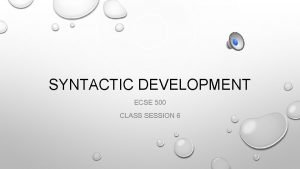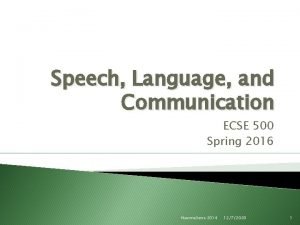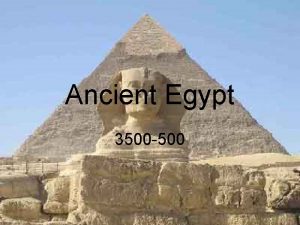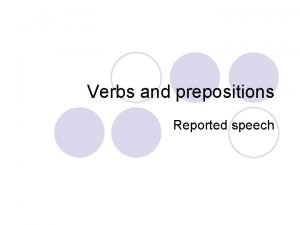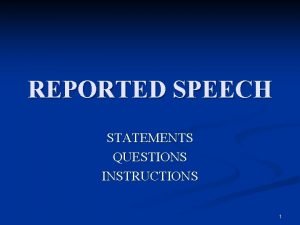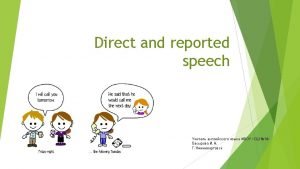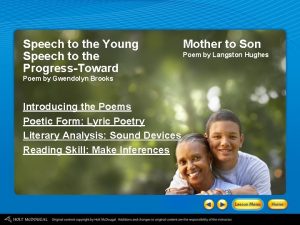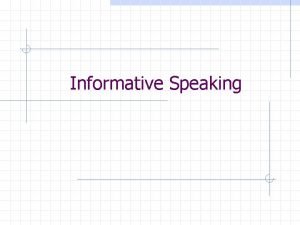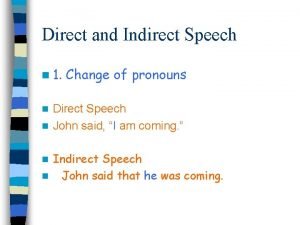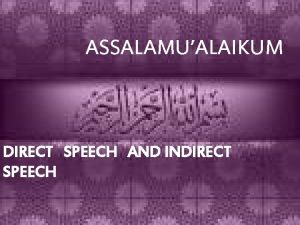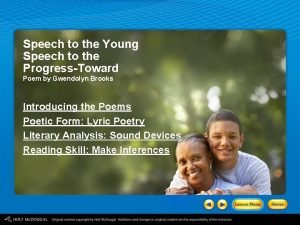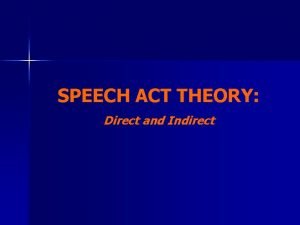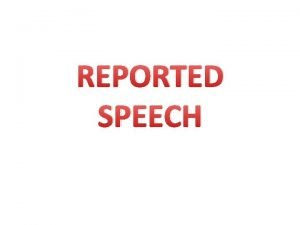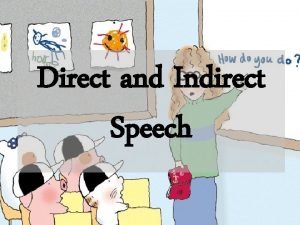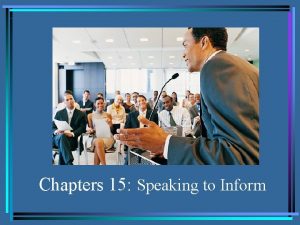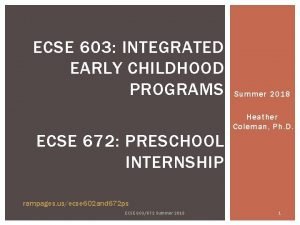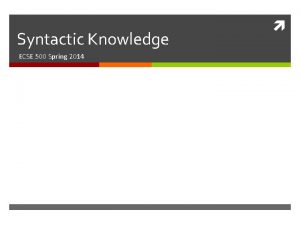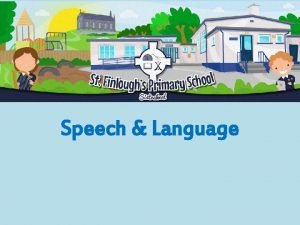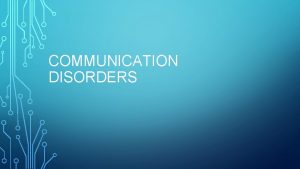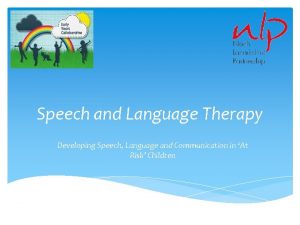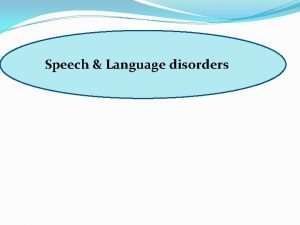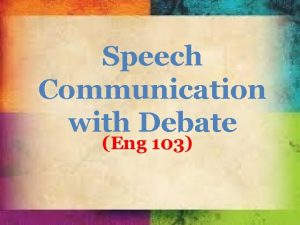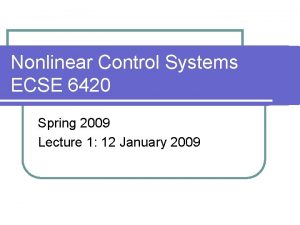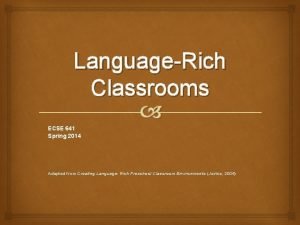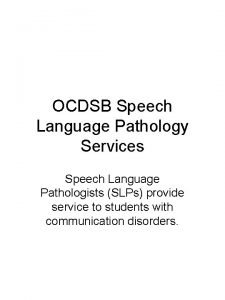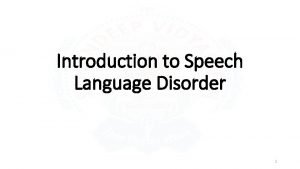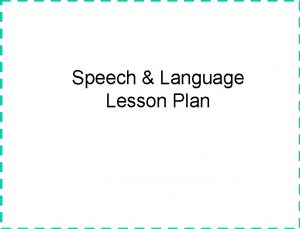Speech Language and Communication ECSE 500 Spring 2016




















- Slides: 20

Speech, Language, and Communication ECSE 500 Spring 2016 Huennekens 2014 12/7/2020 1

Definition of Language � Any code employing signs, symbols, or gestures used for communicating ideas meaningfully between human beings. ◦ Social tool to communicate meanings, feelings, and intentions. ◦ Language comprises of receptive skills (understanding) and expressive skills (use) and includes both written and oral forms. Huennekens 2014 12/7/2020 2

Theories of Language � Behavioristic (Learning): Skinner ◦ Language is behavior � Nativistic or psycholinguistic: Chomsky ◦ Child is prewired for language development and the environment triggers its emergence � Interactionistic: Piaget ◦ Language occurs through fixed developmental stages Huennekens 2014 12/7/2020 3

The Learning Perspective • Infant begins with no knowledge of language, but possesses ability to learn it through reinforcement and imitation � The Learning perspective argues that children imitate what they see and hear, and that children learn from punishment and reinforcement. (Shaffer, Wood, & Willoughby, 2002). � B. F. Skinner argued that adults shape the speech of children by reinforcing the babbling of infants that sound most like words. (Skinner, 1957, as cited in Shaffer, et. al, 2002). � � Huennekens 2014 12/7/2020 4

The Nativist Perspective � � � The nativist perspective argues that humans are biologically programmed to gain knowledge. Noam Chomsky proposed that all humans have a language acqusition device (LAD). The LAD contains knowledge of grammatical rules common to all languages (Shaffer, et. al, 2002) and allows children to understand the rules of whatever language they are listening to. Chomsky also developed the concepts of transformational grammar, surface structure, and deep structure. Transformational grammar is grammar that transforms a sentence. Surface structures are words that are actually written. Deep structure is the underlying message or meaning of a sentence. (Matlin, 2005). Huennekens 2014 12/7/2020 5

Interactionist Theory � Interactionists argue that language development is both biological and social. Interactionists argue that language learning is influenced by the desire of children to communicate with others. � The Interactionists argue that "children are born with a powerful brain that matures slowly and predisposes them to acquire new understandings that they are motivated to share with others" ( Bates, 1993; Tomasello, 1995, as cited in shaffer, et al. , 2002, p. 362). � The main theorist associated with interactionist theory is Lev Vygotsky. His model of collaborative learning. Collaborative learning is the idea that conversations with older people can help children both cognitively and linguistically ( Shaffer, et. al, 2002). Huennekens 2014 12/7/2020 6

Language Components & Skills � Form ◦ Phonology ◦ Morphology ◦ Syntax � Content ◦ Semantics � Use ◦ Pragmatics Huennekens 2014 12/7/2020 7

Phonology � Study and use of individual sound units in a language and the rules by which they are combined and recombined to create larger language units. � Phonemes are the unit of sound such as /s/ or /b/ , they do not convey meaning. � Phonemes alter meaning of words when combined (e. g. , sat to bat). Huennekens 2014 12/7/2020 8

Morphology � Study and use of morphemes, the smallest units of language that have meaning. � A morpheme is a group of sounds that refers to a particular object, idea, or action. ◦ Roots can stand alone (e. g. , car, teach, tall) ◦ Affixes are bound such as prefixes and suffixes and when attached to root words change the meaning of the words (e. g. , cars, teacher, tallest) Huennekens 2014 12/7/2020 9

Syntax � Study of the rules by which words are organized into phrases or sentences in a particular language. � Referred to as the grammar of the language and allows for more complex expression of thoughts and ideas by making references to past and future events. Huennekens 2014 12/7/2020 10

Semantics � The larger meaning component of language. � More than single words, includes complex use of vocabulary, including structures such as word categories, word relationships, synonyms, antonyms, figurative language, ambiguities, and absurdities. Huennekens 2014 12/7/2020 11

Pragmatics � Knowledge and ability to use language functionally in social or interactive situations. � Integrates all the other language skills, but also requires knowledge and use of rule governing the use of language in social context. Huennekens 2014 12/7/2020 12

Functionalist Language Theory Pragmatics Syntax Phonology Morphology Semantics Huennekens 2014 12/7/2020 13

Preschool and Kindergarten � Difficulty with readiness skills: counting, naming colors, naming the days of the week, and using scissors. � Unable to follow simple directions, follow a story line, or enjoy listening to stories. � May exhibit immature-sounding speech, word finding difficulties, and inability to name common objects. Huennekens 2014 12/7/2020 14

Elementary Students � Limited ability to identify sounds, analyzing and synthesizing sound sequences and segmenting words. � Problems with temporal and spatial concepts (e. g. , before-after, some, few). � Word finding (retrieval) difficulties exist. � Problems sounding out and blending sounds. � Problems with expressive and oral language. Huennekens 2014 12/7/2020 15

Secondary Students � Tend to be passive learners and lack metacognitive skills. � Problems gaining information from class lectures and textbooks, completing homework, following classroom rules, demonstrating command of knowledge through test taking, expressing thoughts in writing, participating in classroom discussions, and passing competency exams. Huennekens 2014 12/7/2020 16

Bilingual and Culturally Diverse Students � Assessment should be conducted in the student’s primary language. � Assessment should examine writing, reading, listening, and speaking skills. � Assessments should include both quantitative measures (i. e. , formal tests) and qualitative measures (e. g. , observations, adapted test instruction, and a language sample). Huennekens 2014 12/7/2020 17

Students with Intellectual Disability � Develop language more slowly, including both receptive & expressive delays � Often don’t use make use of incidental learning opportunities � May have insufficient interactions with children with more skilled language use � Frequently less effective in social communication Huennekens 2014 12/7/2020 18

Students with Behavior Disorders � May possess age-appropriate skills at phonemic and morphemic level, but have difficulties with syntax, semantics, and pragmatics � Difficulty expressing ideas, feelings, concerns, and needs � Oral language may be contain profanity � Difficulty with social communication Huennekens 2014 12/7/2020 19

Students with Learning Disabilities � Problems understanding or using spoken or written language (definition) � Problems with word retrieval and word choice � Ambiguity and lack of cohesion � Inefficient decoding of messages presented by speech of others � Uneven language abilities in both school and social settings Huennekens 2014 12/7/2020 20
 Ecse 500
Ecse 500 Ecse 500
Ecse 500 Bae yong-kyun
Bae yong-kyun Spring summer months
Spring summer months 3500 / 500
3500 / 500 Match these sentences in direct and reported speech
Match these sentences in direct and reported speech Pure speech and symbolic speech
Pure speech and symbolic speech Ann says i'm tired
Ann says i'm tired Direct speech and reported speech
Direct speech and reported speech Direct dan indirect speech
Direct dan indirect speech Reported speech form
Reported speech form Reported speech and quoted speech
Reported speech and quoted speech Gwendolyn brooks: “speech to the young,”
Gwendolyn brooks: “speech to the young,” Informative vs persuasive
Informative vs persuasive Direct and indirect speech wh questions examples
Direct and indirect speech wh questions examples We in reported speech
We in reported speech Speech to the young gwendolyn brooks
Speech to the young gwendolyn brooks Direct speech
Direct speech Said present simple
Said present simple Reported speech words
Reported speech words Informative vs persuasive speech
Informative vs persuasive speech
